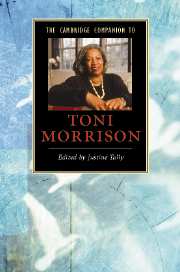8 - Toni Morrison’s literary criticism
from Part II - Toni Morrison’s criticism and editing
Published online by Cambridge University Press: 28 January 2008
Summary
In “Unspeakable Things Unspoken: The Afro-American Presence in American Literature” and Playing in the Dark: Whiteness and the Literary Imagination, Toni Morrison contributes significantly to the debate about the canon of American literature in general and, in particular, its underlying discourse of what she calls the “dark, abiding, signing Africanist presence.” She uses 'Africanism' as a term for denoting the undercurrent of blackness in American literature and culture, on the one hand, and as a term for designating the unspeakable in discourses about class, sexuality, issues of power and domination, on the other. The metaphor she employs most prominently is that of the map that needs to be redrawn in order to lay bare the intellectual legacy of the African American in the United States, an endeavor that she compares to “the original charting of the New World” (Playing, 3). The earlier article and the volume are dazzling pieces of scholarship, thoughtful and provocative analyses of the presence of African American characters, themes, language, and structure in American literature. They are grounded in African American criticism and have turned out to be a persistent call to arms answered by an array of scholars. In the following my analysis will be divided into a discussion of the content and main points of Morrison's critical theory, then an investigation of its theoretical background, and, as a third part, recent scholarly responses.
Both pieces of criticism foreground Morrison the scholar, the Professor of the Humanities, with training and various teaching experiences in departments of English and the Humanities, and demonstrate, as Nancy J. Peterson says, her high stature as a writer and her “prominence as a cultural commentator.”
- Type
- Chapter
- Information
- The Cambridge Companion to Toni Morrison , pp. 115 - 124Publisher: Cambridge University PressPrint publication year: 2007
- 1
- Cited by

